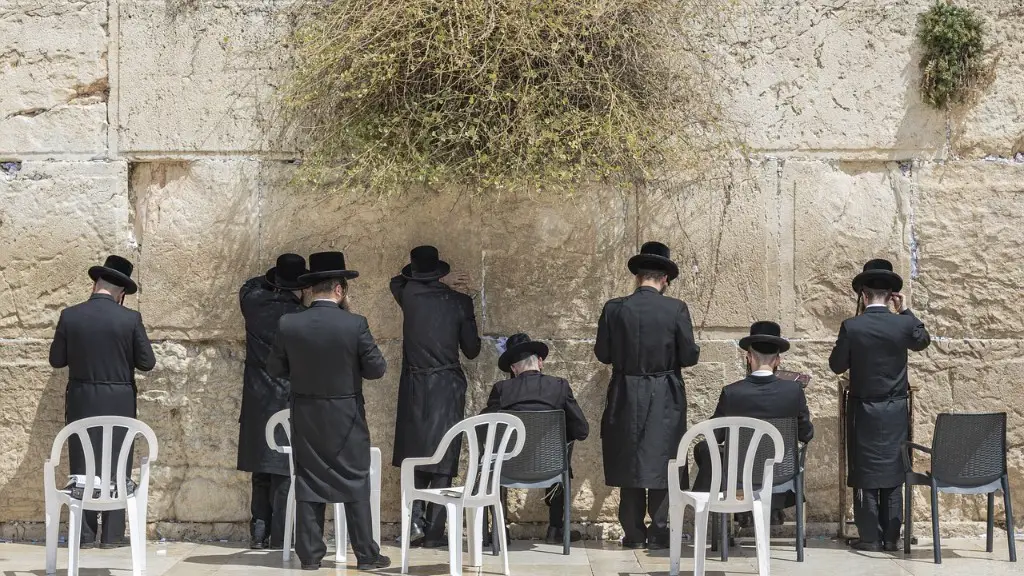Background Information
Judaism is a religion practiced by around 15 million people around the world. At its core, it is a way of life based on the teachings of the Hebrew Bible, commonly referred to as the Tanakh and Talmud. Jewish law, tradition, and belief systems are rooted in the teachings of rabbis and are guided by the Torah and other authoritative texts. Judaism is based on the belief in one God and the divine mission of the Jewish people – to bring a message of peace and justice to the world.
Judaism is not a single, monolithic religion, but encompasses many differing views and interpretations of Jewish law, tradition, and belief. Jews have a variety of ways of expressing their devotion and commitment to living a religious life. There are a variety of rituals, customs, prayers, and shared beliefs that guide the faith and practice of Judaism.
The 613 Mitzvot
The core of Jewish law, Halakha, is composed of the 613 Mitzvot or commandments, which are divided into 248 positive commandments (“do these”) and 365 negative commandments (“do not do these”). Many view the 613 Mitzvot as a guiding light to living an ethical and moral life. They can be broken down into categories such as Shabbat, kashrut (dietary laws), Taharat haMishpacha (family purity laws), and more.
The 613 Mitzvot provide an overarching structure to guide Jewish life. Each commandment is thought to have a spiritual lesson to be learned, as well as a practical lesson to be applied in day to day life. Each commandment is seen as a way to build a relationship with God, as well as to strengthen the relationship between the Jewish people and their land and culture.
Rituals and Traditions
Rituals and traditions are important elements of the Jewish faith. They are an integral part of the practice of living a Jewish life. Rituals, customs, and prayers make it easier to observe the 613 Mitzvot and help to make them meaningful. They also provide the Jewish community with a sense of unity and connectedness.
Some rituals and traditions are performed on a regular basis, such as the Shabbat service, prayer services, and Passover Seder. Other rituals and traditions such as Bar/Bat Mitzvah, wedding ceremonies, and funerals, are performed less often. These rituals are often accompanied by special rituals, such as lighting Shabbat candles, mayim acharonim (washing the hands), kiddush (blessing the wine), and havdalah (blessing the Sabbath ship).
The Role of the Torah and Talmud
The Torah documents the beliefs and instruction given to the Jewish people by God, including the 613 Mitzvot. It serves as a source of guidance and wisdom, and as an anchor point for Jewish life. The Talmud is a collection of commentaries and teachings based on the Torah. It is composed of two main parts, the Mishnah, which is a collection of Jewish laws and traditions, and the Gemara, which is a commentary on the Mishnah. While the Torah is seen as the bedrock of Jewish life, the Talmud helps to interpret and clarify the law and teachings of the Torah.
The Torah and Talmud serve as a common source of guidance for Jews around the world, as well as a source of debate among scholars. The interpretations of the Torah and Talmud are ever-evolving, and in many ways serve as a guide for navigating the complexities of being Jewish in a diverse and changing world.
Modern Jewish Thought
Modern Jewish thought is the product of centuries of evolution of the Jewish faith, culture, and practice, as well as interactions with cultures and people from around the world. This includes diverse interpretive approaches to the source texts and a growing awareness of the complexities of modern life.
In the modern era, Jews have continued to look to the Torah, Talmud, and other ancient texts as guides. But they have also sought to bring contemporary perspectives to bear on the questions posed by the texts and to engage with issues that have arisen in the ever-changing global environment.
MDacrv
Jewish Education
Jewish education is essential for young Jews to participate in the shaping of their own religious and cultural identities. Jewish learning is based on an integrated and holistic approach. This approach combines both academic learning and experiential learning.
The modern education system is based on the principles of inclusion, collaboration, critical thinking, and problem-solving that exemplify Jewish values and traditions. Jewish studies, combined with secular disciplines such as math, science, and language, can equip children and young adults with the skills necessary to become informed members of the global Jewish community. By engaging with Jewish texts, history, and culture, students of all ages can gain knowledge, build community, and cultivate a deeper understanding of their place in the modern world.
The Sanctity of Life
The sanctity of life is a core tenet of Judaism, as expressed in the famous words of Lo taamod al dam reekhah – “Thou shalt not murder.” This commandment implicitly calls for respect of all life, committed by all to uphold the value of human life over all else.
Judaism also emphasizes the importance of social justice and caring for the vulnerable. This includes providing relief and aid to the poor, the sick, orphans, and widows. By establishing a system of social justice and caring for the needy, Jewish tradition promotes the sanctity of life. This is reflected in the Jewish practice of strong family and community ties, mutual responsibility, and shared commitment to charity and justice for all.
The Role of Forgiveness
The role of forgiveness in Judaism is also an integral element of the faith. Forgiveness is viewed as an act of deep humility, as well as a necessary step towards healing. It is seen as an act of self-sacrifice, as well as a way to restore the relationship between two people. Judaism views forgiveness not only as a religious obligation, but also as a moral imperative for peaceful relationships and community.
Jewish tradition encourages individuals to express their regret for wrongdoings and to seek forgiveness wherever possible. This is done by performing the mitzvah of teshuva (repentance) or making amends with those whom they have wronged. The ultimate goal of teshuva is to repair the broken relationship between God and the human being.
The Role of Generosity
Generosity is an often overlooked part of Jewish life. Jewish teachings emphasize the importance of sharing resources and granting aid to those in need. This is expressed in the phrase tikkun olam (repairing the world), which suggests that by contributing to the greater good, one can make a positive difference in the world.
Generosity is also seen in the practice of tzedakah, or charity, which calls on Jews to give a portion of their income to those in need. This is seen as an act of loving kindness and an essential part of living a moral and righteous life.
Generosity is also a part of the Passover ritual, as part of the mitzvah of sending gifts of food to the poor on the Jewish holiday. Jews are also encouraged to give of their time, energy, and resources to those in need, as an expression of the Jewish commitment to justice, service, and compassion.
The Power of Prayer
The power of prayer is an important element of Jewish life. The practice of tefilah, or prayer, is seen as a means of expressing one’s deepest emotions and connecting to God. Prayer is a way for Jews to come together and express their faith, as well as a source of comfort and consolation.
The practice of tefilah is deeply rooted in Jewish tradition, with prayers that trace back to the ancient rabbis. It is a core part of daily devotional practices, as well as life-cycle rituals and the communal offering of prayers. Through prayer, Jews can connect with their lineage, affirm their commitment to Jewish tradition, and bring comfort to those who are in need.

